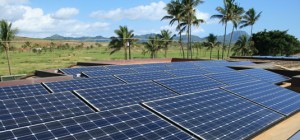 As I’ve covered before, the State of Hawaii has halted its rooftop solar incentive program (“net metering,” where solar customers get full retail electricity credit for any surplus solar they generate). Now state regulators are proposing to replace it with two options, a “grid-supply” option and a self-supply option. The outcome will be a “postcard from the future” for other states, given that Hawaii leads the country in rooftop solar penetration and high electricity prices.
As I’ve covered before, the State of Hawaii has halted its rooftop solar incentive program (“net metering,” where solar customers get full retail electricity credit for any surplus solar they generate). Now state regulators are proposing to replace it with two options, a “grid-supply” option and a self-supply option. The outcome will be a “postcard from the future” for other states, given that Hawaii leads the country in rooftop solar penetration and high electricity prices.
The grid-supply option would replace the full retail rate credit for surplus solar electricity that happens under net metering. Instead, customers would get a new tariff for surplus solar power, based on the avoided costs of fossil fuel-based generation during peak generation hours, as measured from July 2014 to June 2015. That translates to $0.151/kWh for Oahu, $0.154/kWh for Hawaii, and $0.172/kWh for Maui. That’s still a good payment for the surplus electricity, but it’s about half of what customers used to get under the full retail rate under net metering. Plus new customers will have to pay a minimum monthly bill of $25.
The self-supply option is primarily designed to support customers who do not export their surplus to the grid. Instead, they would earn retail rate credit for on-site generation that aligns with their demand. In other words, customers would strategically shift their electricity usage to soak up all their surplus solar power, such as by running all their appliances during peak daylight hours. Or they could buy a battery to store surplus solar power for dark times. Utilities would then be required to streamline interconnection for these systems.
The environmental and solar communities basically hate what state regulators are doing, as Utility Dive reports. But these proposals in fact may not dramatically stall the rooftop solar market. For example, my favorite utility, Kauai Island Utility Cooperative (KIUC), ended net metering in 2009 and replaced it with the similar grid-supply option, and their installations continued to climb. Plus, the self-supply option could serve to encourage ‘grid defection,’ as customers with batteries and solar realize they don’t actually need their utility anymore.
Certainly I’d prefer to see a more gradual transition away from net metering, as opposed to the sudden halt that happened in Hawaii. But in the long run, with continuing price declines on solar and batteries, we need to move in this new direction anyway. However, regulators shouldn’t pull the plug too quickly on the current incentives, or they may end up destroying the only bridge to this future. And that’s not a postcard I want to see, no matter how many palm trees are on it.
 Kauai island’s electricity co-op (KIUC) is running circles around pretty much every other utility in the U.S. when it comes to renewables and energy storage. The utility just brought online Hawaii’s largest solar installation to date, with a 12 megawatt facility.
Kauai island’s electricity co-op (KIUC) is running circles around pretty much every other utility in the U.S. when it comes to renewables and energy storage. The utility just brought online Hawaii’s largest solar installation to date, with a 12 megawatt facility.
But the bigger news is that the solar PV is paired with a 6 megawatt lithium ion battery system, as UtilityDive reports. The 60-acre facility will supply 20 percent of the island’s annual power needs.
What about the cost? Well, given that Hawaii imports diesel fuel to burn for electricity, this plant will be an economic winner. KIUC announced that the project will save the utility $250,000 each month on operating costs alone, with the storage helping to smooth the intermittent solar power.
Overall, Kauai is lapping everyone else when it comes to renewables. California just patted itself on the back for setting a goal of 50% renewables by 2030, which is great. But Kauai is on the way to meeting its goal of 38% renewables just by the end of 2015, with 50% by 2023 and 100% renewables by 2045, as a new Hawaii state law will require.
This progress shows what can happen when you have a cooperative ownership model for electricity, as opposed to an investor-owned utility or even municipally owned utility. It also helps of course that Hawaii has high electricity prices and abundant renewable resources. But the leadership at KIUC deserves kudos for pioneering a range of important policies and projects:
KIUC, for its part, has been making waves in the power sector lately with it aggressive adoption of solar, storage, and rate structures to optimize their use.
In September, the cooperative unveiled a deal with SolarCity to construct what it calls the first fully-disptachable solar-plus-storage system, a combination of a 13 MW solar array with a 52 MWh battery system.
That month, KIUC also announced it would conduct a pilot program offering discounted electric rates to encourage customers to shift their energy use to the daylight hours to take advantage of the utility’s solar resources. The program will offer a 25% discount on standard electric rates from 9 a.m. to 3 p.m.
Let’s hope that state regulators and the retrograde investor-owned utility on the other islands take note of KIUC’s success, as well as utilities all across the country. KIUC is showing how you get it done, cleaning the environment and saving ratepayers money in the process.


